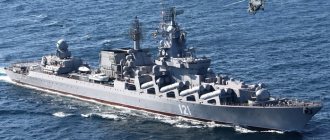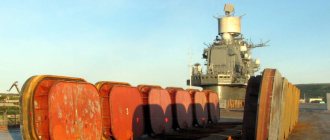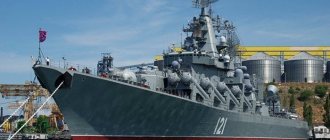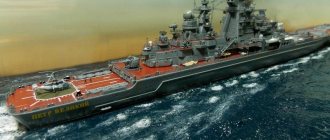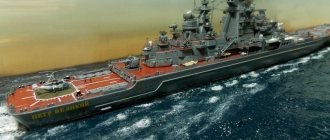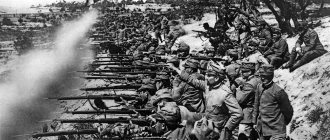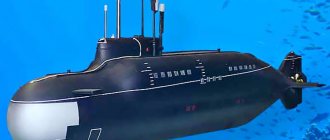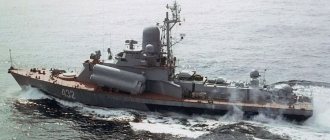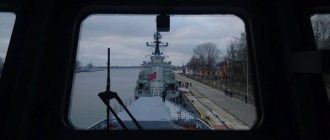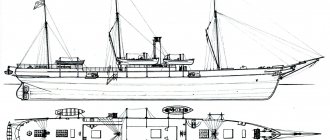The flagship of the very famous US Sixth Operational Fleet (Mediterranean task force), the landing/combined command ship (LCC/JCC 20) Mount Whitney is sent by the command to the Black Sea to coordinate joint operations with NATO forces in the Black Sea region. This is a direct and open challenge, akin to the Cuban Missile Crisis; such actions by the United States and NATO can most likely lead to military conflicts in the region. Why is the flagship of the US Sixth Fleet heading to the Black Sea? The answer lies in Ukraine, of course, and the resumption of hostilities in Donbass
15:36, Moscow, Regular readers of Tochka Zreniya have probably noticed that recently, having betrayed our traditions, we have written little about the aggravation of the confrontation between Russia and NATO, as well as the events in Ukraine, describing only the most important things. A lot of things happened that indicated the imminent start of an escalation, or even the imminent, possible start of some kind of hostilities, for example in Ukraine. By the way, fighting has already begun there. We wrote little about this solely because we sincerely, truly sincerely, tried to avoid the word war, which has been very difficult to avoid lately. It was better not to write anything than to try to avoid such a painful word. However, there are few media left anywhere, and even large television channels, well-known programs that have already uttered and have recently begun to utter this elder word - war. However, we held our ground. But now, in light of the official announcement by the US authorities and the Pentagon about the sending of the flagship of the US Sixth Fleet to the Black Sea, this word is no longer possible to avoid, since such US actions can certainly cause a military clash between the forces of the Russian Federation and NATO, between the forces of the Russian Federation and The United States is in the Black Sea region, which will mean war. Of course, this will not necessarily be so, and God forbid that there will be no war, but its likelihood and possibility increases greatly and many times over from such actions of the United States and NATO. To remain silent about this and not to warn is tantamount to a crime and complicity in this very war. Therefore, we will talk about it, talk so that it does not happen, talk in order to prevent it, talk so that, as in the famous proverb, if you want peace, prepare for war. This will be a difficult conversation, but a very important one.
US Sixth Operational Fleet
The US Sixth Fleet, based in the Mediterranean, is one of the main US strike forces in Europe. This formation includes two aircraft-carrying groups of ships, i.e. two aircraft carriers and support ships, submarines. Missiles and fighters from this particular fleet attacked Yugoslavia sometime in the 90s, and attacked Libya in 1986, and this formation has more than once provided military support to US military operations to invade Libya, Iraq, and Afghanistan.
And so, the flagship of this formation is heading to the Black Sea, to our borders. The flagship of the US Sixth Fleet, the amphibious assault ship Mount Whitney, is the floating headquarters of this fleet. Those. this is the headquarters of the command of the grouping of forces in the Mediterranean. On board the lead ship of the fleet is the commander of the US Sixth Fleet, Vice Admiral Lisa Franchetti, as well as the rest of the command. The ship serves as the fleet headquarters, and coordinates all actions of ships and formations, having all the necessary equipment and resources for this.
Incomplete list of ships
| This section is not completed. You will help the project by correcting and expanding it. |
- Landing Forces Command Ship (LCC) Mount Whitney
- Missile cruiser Anzio
- Cruiser Philippine Sea (CG 58).
- Frigate "Nicholas"
- Destroyer "USS Higgins (DDG 76)"
- Landing ship "USS Ashland (LSD-48)"
- Destroyer USS Ramage (DDG-61)
- Destroyer USS Truxtun (DDG 103)
- Frigate USS Elrod (FFG 55)
Why is the flagship of the sixth fleet heading to the Black Sea?
The flagship is not going to the Black Sea alone. Together with it, the destroyer USS Porter, already known to us, is moving into the Black Sea. Obviously, the role of the American destroyer is combat protection of the flagship. Officially, the United States does not report the purposes of the movement of ships to the Black Sea region. It is reported that in addition to the command of the US Sixth Fleet, the command of the strike forces and support forces of the joint NATO naval forces will be on board.
“Mount Whitney and its staff officers will operate in the Mediterranean and Black Seas with NATO allies and partners, working to ensure security and stability in the region,” the US Sixth Fleet command website says.
At the same time, no exercises are announced, as usually happens in such cases. But joint operations in the Black Sea region of the joint NATO forces are announced! And, one must assume, these are not teachings. Such attempts by the United States have completely different goals. This is certainly and precisely directed against Russia, and openly, and is connected, of course, with Ukraine.
Just a week ago, on October 22, at a meeting of NATO defense ministers in Brussels, NATO discussed plans for the rapid deployment of significant NATO forces to the Black Sea region. The alliance also approved the so-called “security doctrine,” which talks about the Black Sea region and the confrontation with Russia there. And on October 19, US Secretary of Defense Lloyd Austin visited Kiev and stated quite unequivocally that the United States would do its best to pull Ukraine into NATO, regardless of the position of the Russian Federation, which we wrote about in the material on this topic .
And just a couple of days later, after the visit of the head of the Pentagon to Kyiv, full-scale hostilities began in Donbass. Ukrainian troops began massive shelling along almost the entire line of contact, captured populated areas on the demarcation line, and used the Turkish attack drone Bayraktar, which we also reported . Having used an attack drone prohibited by the Minsk agreements, starting shelling and capturing villages in the Donbass, Ukraine completely went out and violated the Minsk agreements. And this, it is worth emphasizing, began immediately after the visit to Kyiv of the head of the Pentagon.
And now, just a week later, the flagship of the US Sixth Fleet and the destroyer Porter are heading to the Black Sea. And all these actions, of course, are simply categorically necessary and important to link together; they form a single whole of some kind of plan and intention, which has been known for a long time. But the situation has changed. If this plan of NATO and the United States was known earlier, now, apparently, its implementation has begun. And this fact is extremely dangerous, capable of provoking a major military conflict and war.
In the militaristic plans of the American imperialists, a special place is given to the Mediterranean Sea, which is explained primarily by its important strategic position.The Mediterranean Sea is the connecting link of three continents - Europe, Africa and Asia; sea and air communications of global importance pass through it, connecting the largest European countries with the states of the Middle East and North Africa, and through the Suez Canal - with the states of Southeast Asia and the Indian region. ocean. It is located near the richest oil fields in the Near and Middle East, accounting for 70 percent. proven reserves of the capitalist world According to foreign press reports, over 200 million tons of oil are transported annually through the Mediterranean Sea. Due to the closure of the Suez Canal at one time, a large number of oil pipelines were connected directly to the ports of this sea.
US imperialist circles view the Mediterranean Sea region and its adjacent territories as a profitable springboard for possible aggressive actions directly against the USSR and other socialist countries.
During the Second World War, American ships in the Mediterranean Sea landed troops in North Africa, on the island. Sicily and the southern coast of France. In 1945, the US Navy command left a small force of ships in the Mediterranean to support American troops in Italy. The headquarters of this formation was located on a floating base of destroyers based in Naples. In August 1947, this mother ship was replaced by a cruiser. On June 1, 1948, U.S. forces in the Mediterranean were officially redesignated as the 6th Operational Fleet.
The US 6th Fleet was finally formed in 1950. It includes surface ships, submarines, naval and marine aviation units and units.
According to the plans of the US Navy command. The 6th Fleet is entrusted with the following main tasks: gaining and maintaining supremacy at sea, conducting combat operations from the sea, providing support to ground forces, supporting the activities of nuclear missile submarines on combat patrols in the Mediterranean Sea, demonstrating the US military presence in the area. It is an important means of intervention by American imperialism in the internal affairs of the Mediterranean countries. The commander of the 6th Fleet is also the commander of the NATO strike naval forces in the South European Theater of Operations. In terms of national organization, he reports to the Commander of US Naval Forces in the European Area (headquarters in London), and in terms of NATO, he reports to the Commander-in-Chief of NATO Allied Forces in the South European Theater (headquarters in Naples). The Deputy Commander of the 6th Fleet for planning and coordinating the activities of the fleet as part of NATO's combined armed forces is also permanently stationed here. He heads the special (coastal) headquarters,
which has 35-40 officers.
US strategists consider the 6th Fleet to be the most versatile, flexible and combat-ready operational force of the US naval forces in Europe, with significant striking power. It includes formations and units of the fleet, naval aviation and marine corps.
In 1977, the 6th Fleet consisted of up to 50 ships and auxiliary vessels, of which two multi-purpose aircraft carriers (on board 160 - 180 aircraft and helicopters), three - four guided missile cruisers, 15 - 20 destroyers and frigates (including guided missile ships ), five - six nuclear submarines, five - six landing ships (including an amphibious helicopter carrier with 32 transport and landing helicopters on board), mobile logistics support vessels. An expeditionary battalion of Marines is constantly on board the landing ships. The number of personnel in the fleet is about 25 thousand people.
The fleet does not have a permanent complement of ships, but is staffed by combat-ready ships, naval aviation units and marines of the Atlantic Fleet (2nd operational fleet), arriving in the Mediterranean for up to six months. The exception is the flagship ship - the URO cruiser (it houses the naval headquarters of the fleet commander), which is in the Mediterranean Sea continuously for two to three years.
When the international situation in the Mediterranean region worsens, the 6th Fleet is usually reinforced with ships sent from the United States. Thus, during the American intervention in Lebanon in 1958, the number of naval personnel in the fleet was increased to 76 warships and auxiliary vessels, and personnel - to 35 thousand people. On the eve of the Arab-Israeli war in October 1973, the total number of ships in the fleet was increased to 65 units.
Organizationally, the 6th Fleet includes several operational formations that are designed to solve both independent and joint tasks. Units are assigned two-digit numbers, where the first digit indicating membership in the fleet is always 6.
60th operational formation
(aircraft carrier) is the main striking force of the fleet. As a rule, it contains at least two aircraft carrier groups. As the foreign press reports, each group includes a multi-purpose aircraft carrier, one or two guided missile cruisers, five or six destroyers and frigates, as well as a nuclear submarine.
At the beginning of 1978, the 6th Fleet included the nuclear-powered multi-role aircraft carrier USS Chester W. Nimitz and the multi-role aircraft carrier USS America. Each aircraft carrier hosts an aviation wing of up to ten squadrons of airplanes and helicopters (about 100 aircraft). Thus, judging by reports from the American magazine Aviation Week, they are based on the aircraft carrier America. two fighter squadrons (12 F-14 Tomcats each), an attack squadron (14 A-6 Intruders, including four tankers), two attack squadrons (14 A-7 Corsairs each), a squadron of early warning aircraft E-2C Hawkeye (four aircraft), a squadron of electronic warfare aircraft EA-6B Prowler (four), a detachment of heavy attack reconnaissance aircraft RA-5C Vigilent (three), a squadron of anti-submarine aircraft S-3A Viking ( ten) and a squadron of SH-3A Sea King anti-submarine helicopters (eight).
The tasks of the 60th operational formation are: striking sea and ground targets with both conventional and nuclear weapons, providing air support to ground forces operating in the coastal direction, amphibious assault forces during their landing and conducting combat operations on the shore, as well as combating surface ships and enemy submarines at sea.
Carrier-based aircraft are capable of delivering conventional or nuclear weapons to targets located at a distance of up to 1,800 km from the aircraft carrier. A characteristic feature of the aircraft carrier formation, according to American military experts, is its high maneuverability, allowing the formation to move over a distance of up to 600 miles (about 1,100 km) within a day.
In everyday conditions, as the foreign press reports, the fleet's aircraft carrier groups operate separately at a distance of about 400 miles from each other. Every day, aircraft from the aircraft carrier make about 120 takeoffs and landings. The presence of a corner deck and other special devices allows aircraft to land at intervals of 30 seconds. During the six-month cycle of an aircraft carrier's stay in the Mediterranean, the air wing's flight hours are up to 3,000 hours.
Judging by the materials of the foreign press, 70 percent. aircraft carrier aircraft must be in constant readiness for departure. However, according to military experts, this level of combat readiness is not always maintained.
61st operational formation
(amphibious landing) is intended for the transport by sea and landing of Marine Corps landings on the coast. It includes an ARG (Amphibious Ready Group) amphibious ship group on duty, including an amphibious helicopter carrier, an amphibious helicopter dock ship, an amphibious transport dock, a tank landing ship and an amphibious cargo transport. The ships of this group are capable of deploying and ensuring the landing of 1800-2000 marines (expeditionary battalion) on the shore using amphibious landing craft or deep in the coast using transport-landing helicopters or a combined method.
The landing ships of the duty group are changed every six months.
(Marines) is an expeditionary battalion (a battalion of Marines with attached tanks, artillery and helicopters). It is staffed, as a rule, from the 2nd US Marine Division. The change of battalion is carried out simultaneously with the change of landing ships of the duty group on which they are located.
63rd operational formation
(service forces) solves the problems of logistics support for ships and aircraft of the 6th Fleet. It includes high-speed integrated supply transport, special spring and ammunition transports, tankers, a fuel tanker, food transport, a floating base for destroyers, an ocean tug, a rescue vessel, a floating workshop and other auxiliary vessels.
The headquarters of the formation controls the consumption of fuel and oil products by the fleet's warships and ensures their refueling. American tankers in the Mediterranean Sea, according to foreign press reports, are capable of carrying about 100,000 tons of fuels and lubricants on board.
Almost all of the logistics supplies for the ships of the 6th Fleet are delivered from the United States. Every month, over 1,550 tons of food and about 300 tons of basic consumables are delivered from Norfolk to the Mediterranean Sea for fleet personnel alone. Fresh produce is purchased from foreign ports.
The US Navy command devotes significant attention to developing methods for replenishing ships directly at sea in exercises. According to the American press. During the year, the 63rd Task Force carries out more than 2,500 operations to replenish supplies of ships at sea and on the move, with 10 percent of them being they involve transport helicopters.
65th operational formation
(temporary) created periodically to perform special tasks. In 1966, it was created to search and recover the B-52 bomber and nuclear bombs that fell with it into the sea in the Polomares area (Spain), and in October - November 1971 - to test new mines and equipment for minesweepers from acoustic helicopters and magnetic min. It included a unit of mine-sweeping forces, including a headquarters group and four minesweeper helicopters SP-53A Sea Steelen. The unit was based at the Souda airbase (Crete).
66th operational formation
(temporary) is intended to strengthen the anti-submarine defense of the aircraft carrier formation of the 6th Fleet in the event of complications in the situation in the Mediterranean Sea.
67th operational formation
(anti-submarine) searches for and destroys enemy submarines, as well as conducts reconnaissance. It includes the R-ZS Orion base patrol aircraft operating from the US Naval Air Bases Sigonella (Sicily) and Suda (Crete), as well as a squadron of reconnaissance aircraft based at the US Naval Air Base Rota (Spain).
69th operational formation
(submarine force) includes several nuclear submarines based in La Maddalena (Sardinia Island).
For the basing and calling of fleet ships, naval bases and ports in Italy, Greece, Turkey, Spain and on the islands of Malta and Crete are used. The US Navy is making unrelenting efforts to turn some of these ports into permanent bases for its fleet. According to foreign press reports, the United States has already achieved agreement to equip and use the Italian port of La Maddalena, as well as the Spanish ports of Ceuta and Chartagene, as naval bases. The lease of Forward Naval Base Rota has been extended. Negotiations are underway with the Israeli government to lease the territory of the port of Haifa for basing American ships.
During the Arab-Israeli conflict of 1967, to support fleet operations in the eastern Mediterranean, the Americans created a forward operating base in Souda Bay on the island. Crete. Here, on the floating base of destroyers, current repairs of ships of the 6th Fleet are carried out. Repair work is also being carried out on the nuclear missile submarine base ship located at the forward naval base of Rota and the nuclear submarine base ship at La Maddalena.
To ensure the smooth functioning of the fleet supply system, Naples and Rota have special logistics coordination departments that use aircraft from the 24th Naval Air Transport Squadron to transport cargo. Typically, these aircraft take off from Rota or Sigonella airfields and fly on "special" routes determined by actual cargo requirements. Every month, at least 250 tons of various cargo are delivered to the aircraft carriers of the 6th Fleet by carrier-based transport aircraft.
Combat training
The 6th Fleet is being carried out in accordance with plans for its use both in limited (local) conflicts and in a general nuclear war. It is aimed at increasing the combat readiness primarily of the naval strike forces - aircraft carrier groups, as well as anti-submarine forces and marine forces. As reported in the foreign press, the ships of the 6th Fleet are over 50 percent. time at sea, participating in various exercises. The 6th Fleet spends more than half of its combat training time in joint exercises with the navies of other NATO countries in the Mediterranean (Italy, Greece, Turkey, as well as Great Britain and France). During these exercises, aircraft carrier groups practice the tasks of carrying out strikes with carrier-based aircraft against sea targets and ground targets, providing air support to ground forces in the coastal areas of the South European theater of operations, combating enemy surface ships and submarines, landing amphibious assault forces and in anti-aircraft and anti-submarine warfare. defense of naval formations. Similar tasks are solved by the 6th Fleet in exercises such as National Week, conducted according to the national plans of the US Navy twice a year. The 6th Fleet usually practices tasks of combating enemy surface ships in bilateral exercises of aircraft carrier groups, during which each of these groups, using camouflage means and maintaining complete radio and radio silence, maneuvers in a given area, trying to detect and destroy the “enemy.” " The American press reports that, as a rule, such exercises end successfully - with the “sinking” of one of the aircraft carriers and several escort ships.
According to Pentagon leaders, the 6th Fleet, being a “weapon of intimidation,” is constantly in a high degree of combat readiness and is already staffed at wartime levels in peacetime. Being the base for the formation of NATO strike naval forces in the South European theater of operations, it can, as the events of recent years show, act independently, ensuring the implementation of the imperialist policy of the United States in the Mediterranean region, sometimes completely without coordinating its activities with partners in the NATO bloc.
Thus, on the night of October 24-25, 1973 (during the Arab-Israeli War), the 6th Fleet was transferred to combat readiness state No. 3 without notifying its allies, and its main forces (two aircraft carrier groups and a group of landing ships with naval infantrymen on board) concentrated in the area south of the island. Crete is in close proximity to the battlefield. In addition, the third aircraft carrier group was introduced into the Mediterranean Sea (the aircraft carrier John F. Kennedy with three escort ships sent from the North Sea), and the aircraft carrier Hancock with escort ships (from the 7th Fleet) arrived in the Arabian Sea. to ensure American presence south of the conflict area.
The above, far from complete data from the foreign press on the activities of the 6th Fleet of the US Navy indicate that it is one of the main instruments of the expansionist policy of imperialist circles in the Mediterranean basin.
Captain 1st Rank I. Karemov
Source - “Foreign Military Review” No. 11 1978.
Last update 08/29/2015
Putin's Valdai speech
The President, giving a big keynote speech at the Valdai Forum, also mentioned the visit of the US Secretary of Defense to Kyiv and the US desire to drag Ukraine into NATO in order to establish its own bases near the borders of the Russian Federation. Putin said then that he does not rule out, and even, probably, with a high degree of probability can claim that NATO, under the guise of training centers in Ukraine, can create its own bases and even deliver cruise missiles there.
“Tomorrow missiles will appear near Kharkov, what should we do about it?”, “In Poland and Romania they installed missile defense systems, but with Aegis launchers, on which you can install Tomahawks, strike systems, and this is easy to do, at the click of a button, just change the software. Nobody will even notice this,” “Medium- and shorter-range missiles can also be placed there. Why not?” Vladimir Putin said at the forum.
And then, as if to confirm the words of Vladimir Putin, just a few days later, information appeared that Great Britain could supply Brimstone Sea Spear surface-to-surface missiles to Ukraine. And now, also just a week later, NATO is moving a headquarters ship to the Black Sea to coordinate joint NATO forces, discussing and approving plans for the transfer of forces to the Black Sea region.
Why is NATO and what is the plan?
The answer is clear – Ukraine. All recent actions are related exclusively to Ukraine. But the point itself, of course, is not about Ukraine, but about NATO’s desire to establish its military bases on the border with the Russian Federation, close to it, in order to be able to threaten us and dictate its terms to us.
The US and NATO act in this regard on the basis of a fairly logical, but rather simple policy - this is a “fork”. If one thing doesn’t work out, another will work out, and vice versa. Both are beneficial, just to varying degrees. The first option is more preferable, the second is a backup.
To implement the plan to establish NATO military bases near the borders of the Russian Federation, it is necessary to drag Ukraine into NATO. But there is a big obstacle to this - Donbass. According to NATO's own charter, a country on whose territory there is an unresolved military conflict cannot join the alliance. Such a conflict is the war between Ukraine and its own rebellious regions, Donetsk and Lugansk. As long as this conflict exists, Ukraine cannot join NATO. To solve this problem, a certain military-political fork arises, in accordance with which the United States and NATO act, and we are already seeing the beginning of these actions, active actions, today.
In accordance with this plan, there are two options for solving the problem: option one is the seizure of the western Donbass by Ukraine with the support of the alliance; option two - Donbass falls away from Ukraine forever, it joins the Russian Federation, the USA and NATO take Ukraine and establish their bases there. In the first option, the bases will be installed directly in the Donbass, because they are closer to Russia.
The escalation in Donbass, which is already underway right now, is intended to serve this purpose. That is why the headquarters ship of the Sixth Fleet is moving to the Black Sea. NATO does not know how Russia will behave if Ukraine begins to seize Donbass. There are Russian citizens there - citizens of the republics who have received Russian citizenship. Russia will be forced to protect its citizens and intervene, military of course, if the escalation escalates into a full-scale war in Donbass.
It is precisely in such a case that a NATO group will be in the Black Sea region, which will enter Ukraine in order not to give up the rest of Ukraine to the Russian Federation. He will enter and never leave again, having established his bases there. And this is how they will achieve their goal.
Ideally, they want Ukraine to suppress and seize Donbass, and if the Russian Federation does not intervene in the conflict, and at some stage the NATO command understands this, then NATO troops will also enter Donbass, behind the backs of the Ukrainian Armed Forces, who will also never again will not leave there, establishing their bases there. And this is a fork.
Organization of the command of the Navy and forces of the US Pacific and Atlantic Fleet
The US Fleet Force Command (USFFC - US Fleet Force Command) is a relatively new member of the country's naval forces, formed for the first time in the history of the Navy in 2001 in the wake of the command's just announced "transformation" of the fleet and the national armed forces as a whole, taking into account the challenges and threats of the new century.
Initially, as conceived by the Chief of Naval Staff (at that time Admiral Werner Clark), it was intended mainly to “unload” his apparatus from routine responsibilities for organizing comprehensive logistics support and centrally coordinating the preparation of fleet forces (on the scale of the Atlantic and Pacific fleets) for operational deployment. The commander of the new formation was appointed concurrently to the then-GK Atlantic Fleet (commander since October 2002). Until 2006, the new command, which actually did not have any regular fleet forces in its composition (and subordination), played an inconspicuous role and had a purely auxiliary value, essentially duplicating a number of functions of the Navy headquarters. In May 2006, the new Chief of Naval Staff (Admiral Michael Mullen) significantly elevated the command's status (to 2nd Command Echelon), giving it the strength of the Atlantic Fleet and transforming the position of Commander of the Atlantic Fleet (COMLANTFLT) into the position of Commander of the United States Fleet Forces (COMUSFLTFORCOM). At the same time, his powers were significantly expanded. Being directly subordinate to and being the main adviser to the Naval Command on matters of manning, logistics, equipment and preparation for the operational deployment of all forces of the American fleet, the commander of the USFFC also led the formations (components) of the Navy as part of the joint armed forces (USJFC - US Joint Force Command), North American (US Northern Command) and Strategic (US Strategic Command) commands of the US Armed Forces. The current commander of USFFCOM is (since September 29, 2007) Admiral Jonathan Greenert (headquarters at NAS Norfolk, Virginia). The purpose and main functions of the command of the US fleet forces are justified by the Navy leadership with references to the following conceptual documents:
- The Coordinated 21st Century Seapower Strategy is a new U.S. Maritime Strategy developed jointly by the Navy, Marine Corps, and Coast Guard headquarters and finalized in October 2007.
- The 2007-2008 Chief of Naval Operations (CNO) Guidance directive applies the provisions of the Maritime Strategy to establish a guaranteed advantage of American sea power and global maritime dominance.
- “Navy Strategic Plan”, which is currently fully synchronized with the provisions of the Maritime Strategy and determines the directions for the development of the development program for the future Navy for the period until 2022.
- The Naval Operations Concept, developed in 2006, has now been brought into full compliance with the Naval Strategy and prescribes the future nature of combat operations of the fleet and marines.
In accordance with these guidance documents, the main functions (tasks) of the command of the US fleet forces are determined.
The most important function of the USFFC is to prepare combat-ready Navy forces for deployment to U.S. area commands in coordination with the Commander, Pacific Fleet. It includes:
- organization, recruitment, combat training and equipment of the Atlantic Fleet and all naval forces (including the Pacific Fleet);
- development and implementation of the “Fleet Emergency Deployment Plan” (FRP-Fleet Response Plan) by observing the cyclical nature of combat training of fleet forces, doctrinal concepts for the preparation and conduct of joint operations, including those involving coalition forces, as well as the combat use of information networks;
- coordinated with the zonal commands (2nd echelon) coordinating the forces of the so-called global fleet (Navy Global Force), participation in the development and implementation of a system for conducting joint operations with the gradual deployment of forces to the US Navy in the zones of the Pacific Ocean, Europe, Central Asia, Central and South America;
- determination and generalization of the logistical needs of the Navy for conducting operations, maintaining combat readiness and conducting operational-tactical training of forces;
- increasing the overall combat readiness of the fleet.
Other tasks include:
- Submitting a summary report to the Chief of Naval Staff on the fleet's logistical requirements for maintaining combat capability and readiness of the force (including all naval components within the area commands of the US Armed Forces) and the development of fleet concepts of operations (CONOPS);
- planning the operational employment of the naval component within JFCOM and fleet forces supporting the defensive capabilities of North American Command (NORTHCOM) and US Strategic Command (STRATCOM), including in global strategic operations, and the organization of a unified missile defense of the continental United States, in information operations and in conducting electronic intelligence;
- Performing Anti-Terrorism/Force Protection (AT/FP) duties as assigned by the Chief of Naval Staff, including communicating AT/FP standards and regulations to all Navy units and ships.
The command's area of responsibility is the entire Atlantic Ocean - from the North Pole to the South Tropic and from the coast of the United States to the shores of Western Europe.
What will Russia do?
I really want to believe that if the events described above occur, and everything is heading towards that, Russia will not be afraid to enter into a direct military clash with NATO forces. This, in this case, seems to be the only way out. Otherwise, in the two options described above, no matter what happens, we will get NATO bases on our borders, it’s simply inevitable. To prevent this from happening, it is necessary to ensure that there are no NATO forces there completely, up to Transcarpathia, to the border of Ukraine with Poland and Romania.
Of course, resolving such issues falls exclusively within the prerogative of the country’s president. And, ultimately, it is up to him to decide. But the author of these lines will not tire of repeating the obvious mistake made in this regard back in 2014, when there was a coup in Ukraine. If Russia had intervened then, as the entire Russian and, most importantly, Ukrainian people wanted, millions of Ukrainians were then waiting for Russia as a savior, none of this would have happened now. If this mistake is made again, seven years later, the situation will become even worse. And this will continue to get worse if this is not addressed, until they crawl with their bases and missiles straight to Moscow, and straight to Moscow. And then we will say: “there is nowhere to retreat, Moscow is behind us”? It should not be. And it can't be like that. And it should be different.
Russia has all the means and forces, the necessary resources and support of the population to solve this problem, to solve not one of the options for the fork described above, but to solve it in its own interests, which are not just interests, but vital interests, the interests of national security and stability, interests of the country's survival.
Of course, it is better to solve this without military conflicts, and this could have been done, for example, in 2014, but this was not done. Now, resolving this issue without war is probably many times more difficult, which proves the fatality of the 2014 mistake. But here’s the situation: if we don’t solve it now, then it will become even more difficult, and when they are already completely on our border, the war will cost much more and will be completely inevitable. What to do? This is the most difficult question in this context, to which the author of these lines does not have a clear and precise answer. But it is absolutely clear that doing something is simply vital.
text: Alexander Tochka Publication Tochka Views Advertisers – advertising in TZ
If you find an error, please select a piece of text and press Ctrl+Enter.
